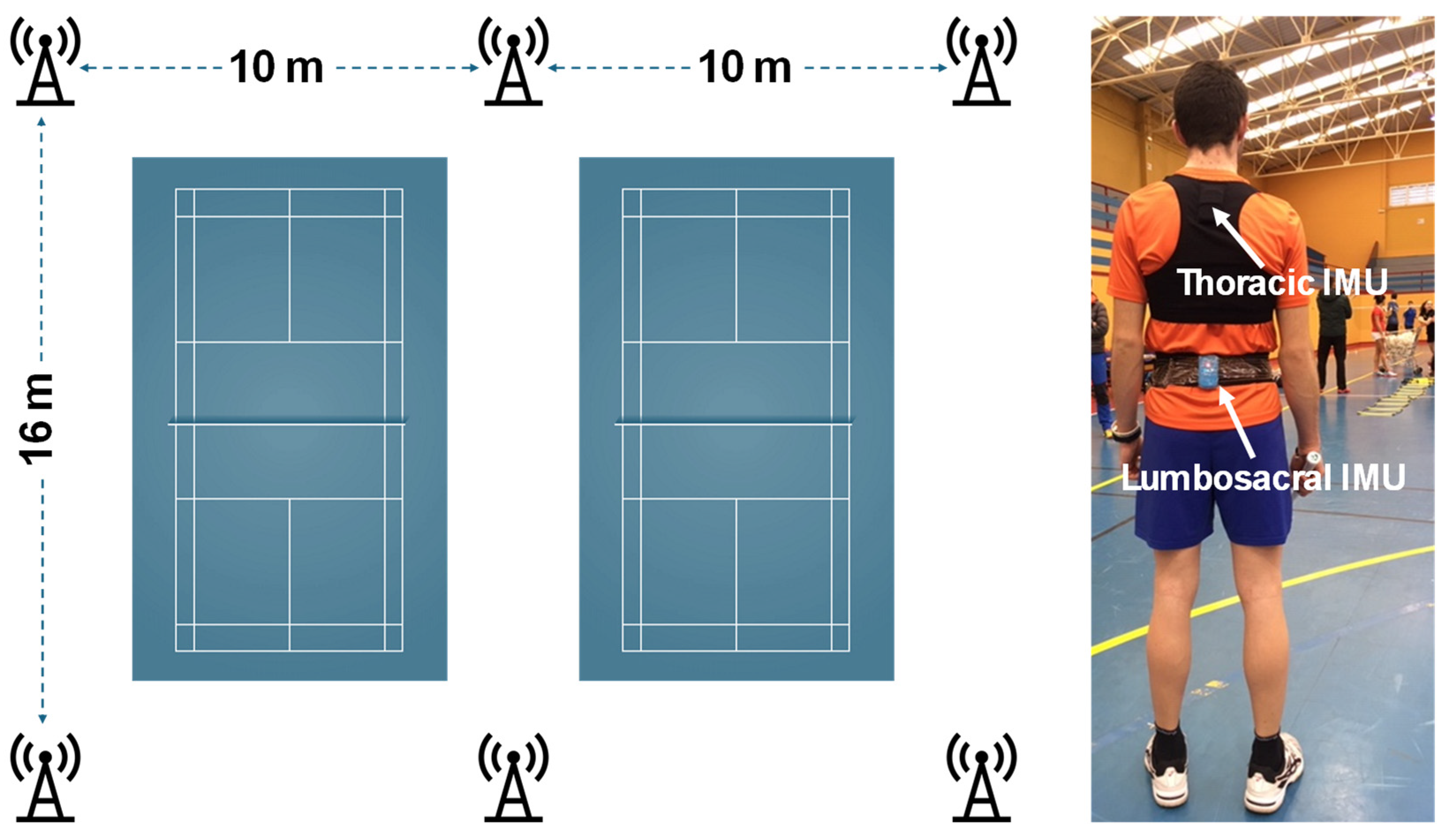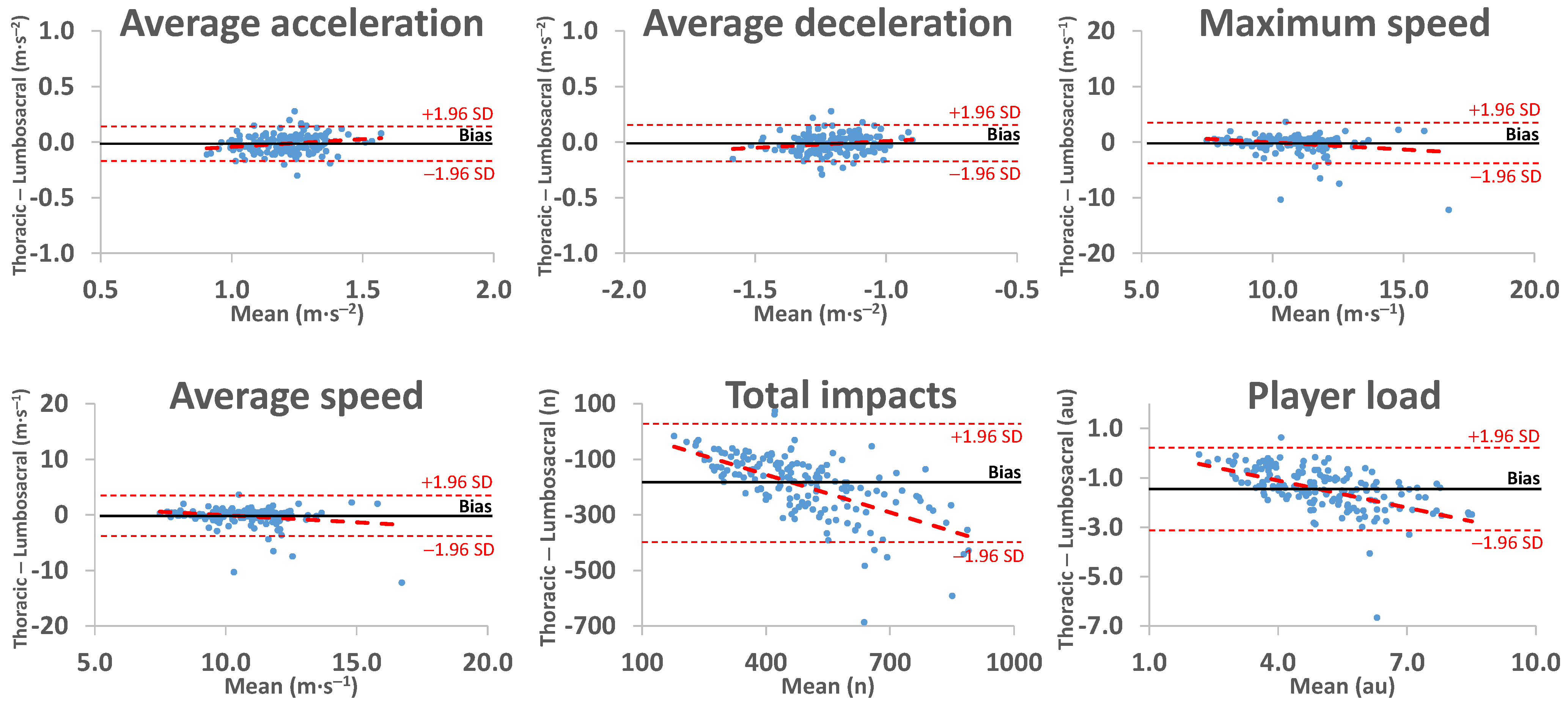The Influence of the Inertial Motor Unit Location (Lumbosacral vs. Thoracic Regions) on the External Load Registered During Badminton Matches
Abstract
:1. Introduction
2. Materials and Methods
2.1. Participants
2.2. Procedures
2.3. System Calibration, IMUs Placement and Data Collection
2.4. Statistical Analysis
3. Results
4. Discussion
5. Conclusions
Supplementary Materials
Author Contributions
Funding
Institutional Review Board Statement
Informed Consent Statement
Data Availability Statement
Acknowledgments
Conflicts of Interest
References
- Impellizzeri, F.M.; Marcora, S.M.; Coutts, A.J. Internal and External Training Load: 15 Years On. Int. J. Sports Physiol. Perform. 2019, 14, 270–273. [Google Scholar] [CrossRef] [PubMed]
- Gamonales, J.M.; Hernández-Beltrán, V.; Escudero-Tena, A.; Ibáñez, S.I. Analysis of the External and Internal Load in Professional Basketball Players. Sports 2023, 11, 195. [Google Scholar] [CrossRef] [PubMed]
- Silva, H.; Nakamura, F.Y.; Castellano, J.; Marcelino, R. Training Load Within a Soccer Microcycle Week—A Systematic Review. Strength Cond. J. 2023, 45, 568–577. [Google Scholar] [CrossRef]
- Harper, D.J.; Carling, C.; Kiely, J. High-Intensity Acceleration and Deceleration Demands in Elite Team Sports Competitive Match Play: A Systematic Review and Meta-Analysis of Observational Studies. Sports Med. 2019, 49, 1923–1947. [Google Scholar] [CrossRef]
- Bradley, E.; Roberts, J.; Archer, D. Determining female-specific high-intensity activity GPS thresholds in women’s rugby union: Use of current use of male-derived absolute speed thresholds underestimates true levels. Eur. J. Sport Sci. 2024, 24, 1079–1085. [Google Scholar] [CrossRef] [PubMed]
- Rennie, M.J.; Kelly, S.J.; Bush, S.; Spurrs, R.W.; Sheehan, W.B.; Watsford, M.L. Phases of Match-Play in Professional Australian Football: Positional Demands and Match-Related Fatigue. Sensors 2022, 15, 9887. [Google Scholar] [CrossRef]
- Villarejo-García, D.H.; Moreno-Villanueva, A.; Soler-López, A.; Reche-Soto, P.; Pino-Ortega, J. Use, Validity and Reliability of Inertial Movement Units in Volleyball: Systematic Review of the Scientific Literature. Sensors 2023, 23, 3960. [Google Scholar] [CrossRef]
- Whiteside, D.; Cant, O.; Connolly, M.; Reid, M. Monitoring Hitting Load in Tennis Using Inertial Sensors and Machine Learning. Int. J. Sports Physiol. Perform. 2017, 12, 1212–1217. [Google Scholar] [CrossRef]
- Brich, Q.; Casals, M.; Crespo, M.; Reid, M.; Baiget, E. Quantifying Hitting Load in Racket Sports: A Scoping Review of Key Technologies. Int. J. Sports Physiol. Perform. 2024, 19, 519–532. [Google Scholar] [CrossRef]
- Bredt, S.G.T.; Chagas, M.H.; Peixoto, G.H.; Menzel, H.J.; Pereira de Andrade, A.G. Understanding Player Load: Meanings and Limitations. J. Hum. Kinet. 2020, 71, 5–9. [Google Scholar] [CrossRef]
- Teixeira, J.E.; Forte, P.; Ferraz, R.; Leal, M.; Ribeiro, J.; Silva, A.J.; Barbosa, T.M.; Monteiro, A.M. Monitoring Accumulated Training and Match Load in Football: A Systematic Review. Int. J. Environ. Res. Public Health 2021, 18, 3906. [Google Scholar] [CrossRef] [PubMed]
- Rojas-Valverde, D.; Gómez-Carmona, C.D.; Fernández-Fernández, J.; García-López, J.; García-Tormo, V.; Cabello-Manrique, D.; Pino-Ortega, J. Identification of games and sex-related activity profile in junior international badminton. Int. J. Perform. Anal. Sport 2020, 20, 323–338. [Google Scholar] [CrossRef]
- Fu, Y.; Liu, Y.; Chen, X.; Li, Y.; Li, B.; Wang, X.; Shu, Y.; Shang, L. Comparison of Energy Contributions and Workloads in Male and Female Badminton Players During Games Versus Repetitive Practices. Front. Physiol. 2021, 12, 640199. [Google Scholar] [CrossRef]
- Liu, T.-H.; Chen, W.-H.; Shih, Y.; Lin, Y.-C. Better position for the wearable sensor to monitor badminton sport training loads. Sports Biomech. 2021, 20, 503–515. [Google Scholar] [CrossRef]
- Alanen, A.M.; Räisänen, A.M.; Benson, L.C.; Pasanen, K. The use of inertial measurement units for analyzing change of direction movement in sports: A scoping review. Int. J. Sports Sci. Coach. 2021, 16, 1332–1353. [Google Scholar] [CrossRef]
- Edwards, S.; White, S.; Humphreys, S.; Robergs, R.; O’Dwyer, N. Caution using data from triaxial accelerometers housed in player tracking units during running. J. Sports Sci. 2019, 37, 810–818. [Google Scholar] [CrossRef]
- Phomsoupha, M.; Laffaye, G. The science of badminton: Game characteristics, anthropometry, physiology, visual fitness and biomechanics. Sports Med. 2015, 45, 473–495. [Google Scholar] [CrossRef]
- Bastida-Castillo, A.; Gómez-Carmona, C.D.; De la Cruz-Sánchez, E.; Reche-Royo, X.; Ibáñez, S.J.; Pino Ortega, J. Accuracy and Inter-Unit Reliability of Ultra-Wide-Band Tracking System in Indoor Exercise. Appl. Sci. 2019, 9, 939. [Google Scholar] [CrossRef]
- Gómez-Carmona, C.D.; Bastida-Castillo, A.; García-Rubio, J.; Ibáñez, S.J.; Pino-Ortega, J. Static and dynamic reliability of WIMU PRO™ accelerometers according to anatomical placement. Proc. IMechE Part P J. Sports Eng. Technol. 2019, 233, 238–248. [Google Scholar] [CrossRef]
- Oliva-Lozano, J.M.; Gómez-Carmona, C.D.; Fortes, V.; Pino-Ortega, J. Effect of training day, match, and length of the microcycle on workload periodization in professional soccer players: A full-season study. Biol. Sport 2022, 39, 397–406. [Google Scholar] [CrossRef]
- Miralles-Iborra, A.; Elvira, J.L.L.; Del Coso, J.; Hernandez-Sanchez, S.; Pino-Ortega, J.; Moreno-Pérez, V. Influence of a football match on landing biomechanics and jump performance in female football players. Scand. J. Med. Sci. Sports 2024, 34, e14518. [Google Scholar] [CrossRef] [PubMed]
- Gómez-Carmona, C.D.; Bastida-Castillo, A.; Ibáñez, S.J.; Pino-Ortega, J. Accelerometry as a method for external workload monitoring in invasion team sports. A systematic review. PLoS ONE 2020, 15, e0236643. [Google Scholar] [CrossRef] [PubMed]
- Ogueta-Alday, A.; Morante, J.C.; Rodríguez-Marroyo, J.A.; García-López, J. Validation of a new method to measure contact and flight times during treadmill running. J. Strength Cond. Res. 2013, 27, 1450–1457. [Google Scholar] [CrossRef] [PubMed]
- Koo, T.K.; Li, M.Y. A Guideline of Selecting and Reporting Intraclass Correlation Coefficients for Reliability Research. J. Chiropr. Med. 2016, 15, 155–163. [Google Scholar] [CrossRef]
- Corbí-Santamaría, P.; Gil-Calvo, M.; Herrero-Molleda, A.; García-López, J.; Boullosa, D.; García-Tormo, J.V. The Impact of Advanced Footwear Technology on the Performance and Running Biomechanics of Mountain Runners. Appl. Sci. 2025, 15, 531. [Google Scholar] [CrossRef]
- Maloney, S.J. Review of the Badminton Lunge and Specific Training Considerations. Strength Cond. J. 2018, 40, 7–17. [Google Scholar] [CrossRef]
- Nagano, Y.; Sasaki, S.; Higashihara, A.; Ichikawa, H. Movements with greater trunk accelerations and their properties during badminton games. Sports Biomech. 2020, 19, 342–352. [Google Scholar] [CrossRef]
- Wylde, M.J.; Lee, M.B.C.; Yong, L.C.; Callaway, A.J. Reliability and validity of GPS-embedded accelerometers for the measurement of badminton specific player load. J. Trainol. 2018, 7, 34–37. [Google Scholar] [CrossRef]
- Encarnación-Martínez, A.; Catalá-Vilaplana, I.; Berenguer-Vidal, R.; Sanchis-Sanchis, R.; Ochoa-Puig, B.; Pérez-Soriano, P. Treadmill and Running Speed Effects on Acceleration Impacts: Curved Non-Motorized Treadmill vs. Conventional Motorized Treadmill. Int. J. Environ. Res. Public Health 2021, 18, 5475. [Google Scholar] [CrossRef]
- Barrett, S.; Midgley, A.; Lovell, R. PlayerLoad™: Reliability, convergent validity, and influence of unit position during treadmill running. Int. J. Sports Physiol. Perform. 2014, 9, 945–952. [Google Scholar] [CrossRef]
- Bland, J.M.; Altman, D.G. Statistics Notes: Correlation, regression, and repeated data. BMJ 1994, 308, 896. [Google Scholar] [CrossRef] [PubMed]
- Walter, S.D.; Eliasziw, M.; Donner, A. Sample size and optimal designs for reliability studies. Stat. Med. 1998, 17, 101–110. [Google Scholar] [CrossRef]




| IMU’s LOCATION | Differences | Correlations | |||||
|---|---|---|---|---|---|---|---|
| Thoracic (T) | Lumbosacral (L) | F | p | ηp2 | ICC | 95% CI | |
| Total Distance (m) | 2202.2 ± 141.8 | 2179.4 ± 118.5 | 1.469 | 0.244 | 0.089 | 0.936 | 0.915–0.951 |
| Explosive Distance (m) | 290.2 ± 44.6 | 280.1 ± 36.3 | 3.340 | 0.088 | 0.182 | 0.836 | 0.787–0.874 |
| Accelerations (n) | 1287.8 ± 97.4 | 1268.7 ± 93.7 | 0.909 | 0.355 | 0.057 | 0.885 | 0.850–0.913 |
| Accelerations 0–2 m·s−2 (n) | 1062.8 ± 125.8 | 1059.3 ± 120.3 | 0.047 | 0.832 | 0.003 | 0.894 | 0.861–0.919 |
| Accelerations 2–10 m·s−2 (n) | 224.9 ± 50.0 | 209.4 ± 42.5 * | 6.953 | 0.019 | 0.317 | 0.795 | 0.736–0.842 |
| Decelerations (n) | 1286.4 ± 98.2 | 1267.4 ± 93.7 | 0.908 | 0.356 | 0.057 | 0.885 | 0.850–0.913 |
| Decelerations 0–2 m·s−2 (n) | 1047.9 ± 118.7 | 1063.1 ± 112.1 | 0.853 | 0.370 | 0.054 | 0.887 | 0.852–0.914 |
| Decelerations 2–10 m·s−2 (n) | 238.5 ± 49.2 | 204.3 ± 31.1 * | 30.475 | 0.000 | 0.670 | 0.792 | 0.732–0.840 |
| Maximum acceleration (m·s−2) | 3.79 ± 0.35 | 3.76 ± 0.33 | 1.475 | 0.243 | 0.090 | 0.735 | 0.662–0.794 |
| Maximum deceleration (m·s−2) | −3.90 ± 0.29 | –3.73 ± 0.27 * | 29.440 | 0.000 | 0.662 | 0.605 | 0.506–0.688 |
| Average acceleration (m·s−2) | 1.18 ± 0.12 | 1.19 ± 0.10 | 4.071 | 0.062 | 0.213 | 0.828 | 0.776–0.868 |
| Average deceleration (m·s−2) | –1.19 ± 0.12 | –1.18 ± 0.09 | 2.061 | 0.172 | 0.121 | 0.800 | 0.742–0.846 |
| Maximum speed (km·h−1) | 13.8 ± 3.6 | 13.7 ± 2.7 | 0.003 | 0.960 | 0.000 | 0.449 | 0.327–0.556 |
| Average speed (km·h−1) | 3.2 ± 0.2 | 3.2 ± 0.2 | 0.170 | 0.686 | 0.011 | 0.903 | 0.872–0.926 |
| Total Impacts (n) | 4485.4 ± 820.0 | 6720.1 ± 1348.9 * | 93.214 | 0.000 | 0.861 | 0.768 | 0.702–0.821 |
| Impacts 1.5–2.0 g (n) | 1881.1 ± 339.0 | 2840.2 ± 372.9 * | 148.149 | 0.000 | 0.908 | 0.749 | 0.679–0.806 |
| Impacts 2.0–2.5 g (n) | 999.2 ± 201.5 | 1496.9 ± 334.1 * | 90.146 | 0.000 | 0.857 | 0.726 | 0.650–0.787 |
| Impacts 2.5–3.0 g (n) | 564.2 ± 151.3 | 833.0 ± 243.2 * | 53.817 | 0.000 | 0.782 | 0.708 | 0.629–0.773 |
| Impacts 3.0–100.0 g (n) | 1040.9 ± 231.9 | 1550.0 ± 448.5 * | 29.187 | 0.000 | 0.661 | 0.627 | 0.532–0.707 |
| Player Load (au) | 50.0 ± 5.1 | 67.3 ± 8.6 * | 98.518 | 0.000 | 0.868 | 0.803 | 0.746–0.849 |
Disclaimer/Publisher’s Note: The statements, opinions and data contained in all publications are solely those of the individual author(s) and contributor(s) and not of MDPI and/or the editor(s). MDPI and/or the editor(s) disclaim responsibility for any injury to people or property resulting from any ideas, methods, instructions or products referred to in the content. |
© 2025 by the authors. Licensee MDPI, Basel, Switzerland. This article is an open access article distributed under the terms and conditions of the Creative Commons Attribution (CC BY) license (https://creativecommons.org/licenses/by/4.0/).
Share and Cite
García-López, J.; Pino-Ortega, J.; Fernández-Fernández, J.; García-Tormo, J.V. The Influence of the Inertial Motor Unit Location (Lumbosacral vs. Thoracic Regions) on the External Load Registered During Badminton Matches. Sensors 2025, 25, 1910. https://doi.org/10.3390/s25061910
García-López J, Pino-Ortega J, Fernández-Fernández J, García-Tormo JV. The Influence of the Inertial Motor Unit Location (Lumbosacral vs. Thoracic Regions) on the External Load Registered During Badminton Matches. Sensors. 2025; 25(6):1910. https://doi.org/10.3390/s25061910
Chicago/Turabian StyleGarcía-López, Juan, José Pino-Ortega, Jaime Fernández-Fernández, and José Vicente García-Tormo. 2025. "The Influence of the Inertial Motor Unit Location (Lumbosacral vs. Thoracic Regions) on the External Load Registered During Badminton Matches" Sensors 25, no. 6: 1910. https://doi.org/10.3390/s25061910
APA StyleGarcía-López, J., Pino-Ortega, J., Fernández-Fernández, J., & García-Tormo, J. V. (2025). The Influence of the Inertial Motor Unit Location (Lumbosacral vs. Thoracic Regions) on the External Load Registered During Badminton Matches. Sensors, 25(6), 1910. https://doi.org/10.3390/s25061910









